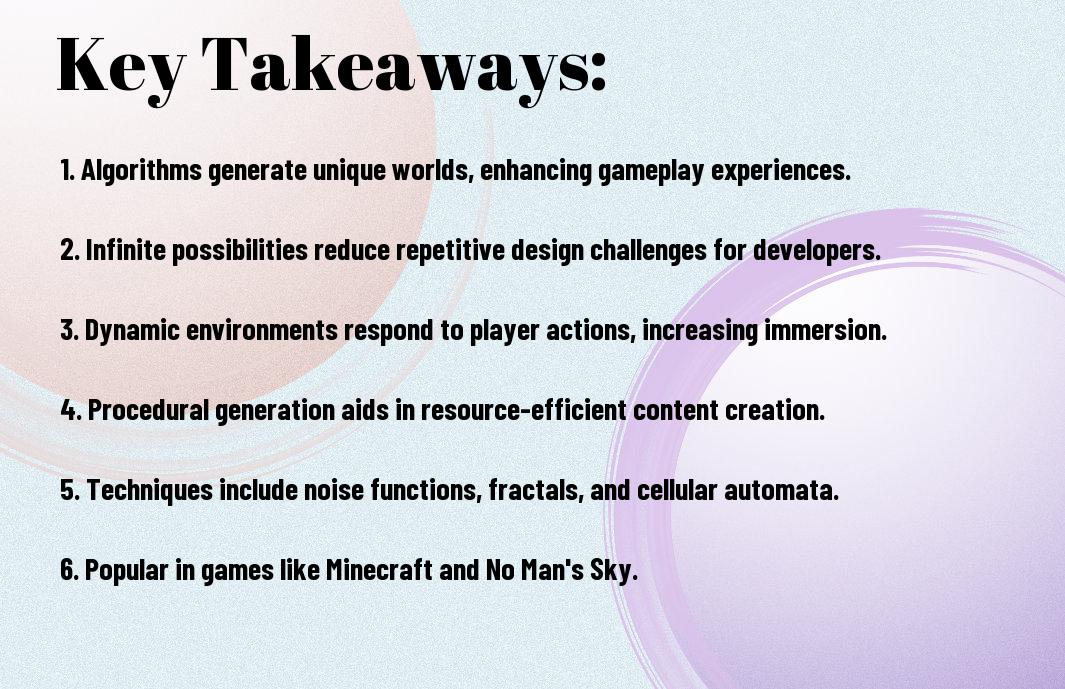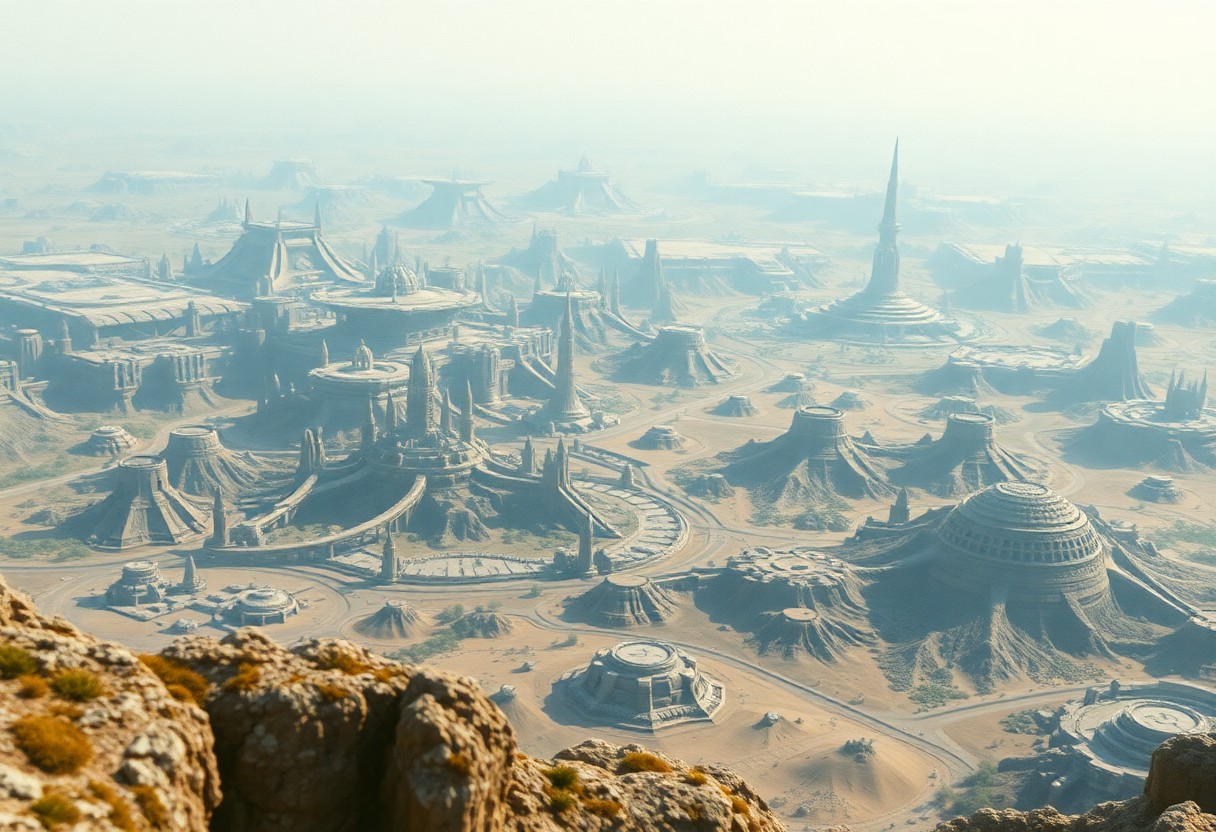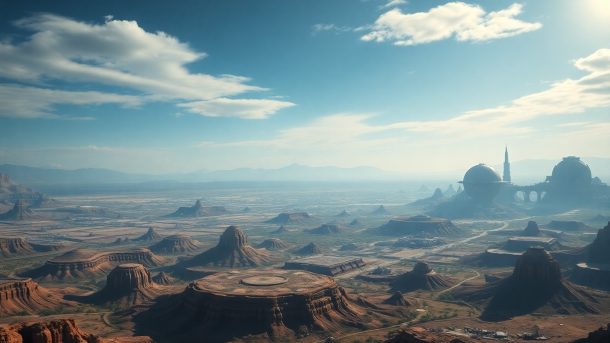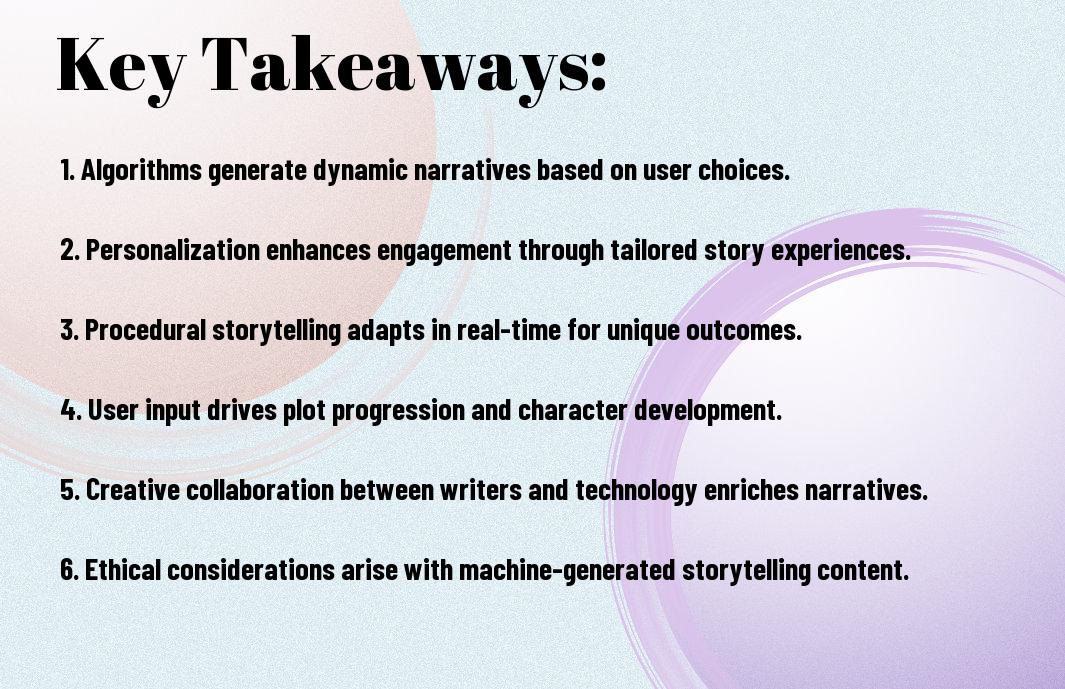As you investigate into the world of game development and simulation, you’ll discover the power of procedural generation. This technique allows you to create infinite worlds, landscapes, and environments using algorithms. With procedural generation, you can generate unique content on the fly, offering your users a new experience each time they interact with your creation. You’ll be able to create vast, diverse, and engaging worlds, limited only by your imagination and the algorithms you employ.
Key Takeaways:
- Procedural generation allows for the creation of vast, unique, and diverse game worlds through the use of algorithms, reducing the need for manual level design and increasing replayability.
- Algorithms can be used to generate terrain, architecture, vegetation, and other environmental features, creating a sense of realism and immersion in the game world.
- Procedural generation can be applied to various aspects of game development, including level design, content creation, and even storytelling, offering a high degree of flexibility and customization.
- The use of noise functions, such as Perlin noise, is a common technique in procedural generation, enabling the creation of natural-looking patterns and structures.
- Procedural generation can help reduce the size of game files, as the game can generate content on the fly, rather than storing it in memory or on disk.
- Game developers can use procedural generation to create games with high replay value, as the generated content is unique each time the game is played, offering a new experience for players.
- The application of procedural generation is not limited to games, as it can also be used in fields such as architecture, film, and simulation, to generate realistic and detailed environments.
Core Principles of Procedural Generation
While exploring procedural generation, you’ll discover that it’s based on algorithms that create content on the fly, allowing for infinite possibilities and unique experiences in your generated worlds.
Algorithm Fundamentals
Following the basics of procedural generation, you’ll find that algorithms are the backbone of this technique, enabling you to create complex and diverse content through a set of predefined rules and processes that you can control and manipulate.
Random Number Generation and Seed Systems
Principally, random number generation and seed systems are vital components of procedural generation, as they allow you to introduce unpredictability and variety into your generated worlds, giving you the ability to create unique experiences each time you use your algorithm.
Core to the concept of random number generation and seed systems is the idea that you can use a seed value to generate a unique sequence of random numbers, which can then be used to create diverse and varied content, such as terrain, buildings, or even entire cities, allowing you to create a virtually endless array of possibilities in your generated worlds.

Terrain Generation Methods
Some of the most impressive examples of procedural generation can be found in terrain generation, where algorithms create vast, unique landscapes. You can learn more about the applications of procedural algorithms in Byte-Sized Tech Review — Procedural Algorithms and Art, which explores the intersection of technology and creativity.
Noise Functions and Height Maps
Across various terrain generation methods, noise functions and height maps play a significant role in creating realistic landscapes, allowing you to generate natural-looking terrain with ease and precision.
Biome Distribution Algorithms
Any attempt to create a diverse and immersive world relies on effective biome distribution algorithms, which enable you to generate varied environments, from lush forests to arid deserts, and everything in between.
Considering your goals for creating a procedurally generated world, you’ll want to examine deeper into biome distribution algorithms, which involve complex mathematical formulas to distribute different biomes across your terrain, taking into account factors like climate, geography, and ecology, allowing you to create a rich and diverse world that feels alive and immersive, and as you explore these algorithms, you’ll discover the endless possibilities they offer for creating unique and engaging environments.

World Building Elements
Once again, you’ll find that procedural generation relies on a set of core elements to create immersive worlds. These elements include flora, fauna, structures, and settlements, all of which can be generated using algorithms to create unique and diverse environments.
Flora and Fauna Generation
Around the globe, you can generate diverse flora and fauna using noise functions and random number generators, allowing you to create realistic ecosystems that simulate the natural world.
Structure and Settlement Placement
An imperative aspect of world building is the placement of structures and settlements, which can be achieved through algorithms that take into account factors like geography, climate, and accessibility, enabling you to create believable and engaging environments.
Even as you generate structures and settlements, you can use algorithms to determine their purpose, size, and layout, allowing you to create a rich and detailed world that feels lived-in and authentic, with your players able to explore and interact with the environment in a meaningful way, making your world feel truly immersive and realistic.
Environmental Systems
Not every game requires a richly detailed environment, but for those that do, procedural generation can create immersive worlds. You can generate terrain, water, and vegetation to craft unique landscapes.
Weather Pattern Generation
Around the concept of weather, you can create realistic patterns using algorithms, allowing you to simulate various conditions that affect your game world. You will be able to generate weather that impacts gameplay and atmosphere.
Day-Night Cycle Implementation
With the right techniques, you can implement a day-night cycle that simulates the passage of time, influencing your game’s atmosphere and challenges. You will be able to create a more engaging experience by incorporating this feature into your game.
Even more complex effects can be achieved by adjusting the day-night cycle to influence various aspects of your game, such as enemy behavior, resource availability, and environmental interactions. You can experiment with different cycle lengths and effects to find the perfect balance for your game, making it more dynamic and engaging for your players.
Content Management
All procedural generation systems require a well-structured content management approach to handle the vast amounts of data being generated. You need to consider how your system will store, retrieve, and manage the generated content to ensure seamless gameplay and optimal performance.
Memory Optimization
Content-wise, you’ll want to focus on reducing memory usage to prevent performance issues. You can achieve this by using techniques such as compression, caching, and lazy loading to minimize the amount of data stored in memory at any given time, allowing your system to run more efficiently.
Loading Techniques
Management of loading times is imperative to maintaining a smooth player experience. You can use techniques like level of detail, occlusion culling, and asynchronous loading to reduce loading times and prevent frustrating delays, keeping your players engaged in your game world.
Further, when implementing loading techniques, you’ll want to consider your game’s specific needs and optimize your approach accordingly. You can use metrics such as loading time, frame rate, and player wait time to evaluate the effectiveness of your loading techniques and make data-driven decisions to improve your game’s performance, ensuring that your players have the best possible experience in your procedurally generated world.
Technical Implementation
For a deeper investigate procedural generation, you can explore Procedural Generation: The Art of Creating Infinite Worlds to understand how algorithms can create immersive experiences.
Engine Integration
Around the time you start implementing procedural generation, you’ll need to consider how it integrates with your game engine, ensuring seamless functionality and optimization.
Performance Considerations
Performance is key when generating infinite worlds, as you’ll need to balance detail with processing power to maintain a smooth experience.
In addition, as you explore into performance considerations, you’ll find that optimizing your algorithms and leveraging multi-threading can significantly enhance your game’s overall performance, allowing you to create more complex and engaging worlds without sacrificing framerate or responsiveness, making your game more enjoyable for your players.
Conclusion
The use of procedural generation allows you to create infinite worlds through algorithms, giving you unparalleled control over your gaming experience. As you explore these generated worlds, you’ll discover new and unique environments, keeping your experience fresh and exciting. With your ability to customize and shape these worlds, you can tailor your gameplay to suit your preferences, making each experience truly yours.
FAQ
Q: What is Procedural Generation and how does it relate to creating infinite worlds?
A: Procedural Generation refers to the use of algorithms to create content on the fly, rather than relying on pre-designed assets. In the context of creating infinite worlds, procedural generation allows developers to generate terrain, landscapes, and even entire worlds using mathematical formulas and algorithms. This approach enables the creation of virtually endless, unique environments, making each player’s experience distinct and unpredictable. By leveraging procedural generation, game developers can create immersive, dynamic worlds that seem to stretch on forever, without the need for manual design of every detail.
Q: How do algorithms contribute to the diversity and realism of procedurally generated worlds?
A: Algorithms play a central role in procedural generation by providing the set of rules and instructions that govern how the world is created. These algorithms can simulate natural processes such as erosion, weather patterns, and geological formations, resulting in diverse and realistic environments. By incorporating noise functions, fractals, and other mathematical concepts, developers can create detailed, varied landscapes that mimic the complexity of the real world. Furthermore, algorithms can be designed to adapt to player interactions, ensuring that the world evolves and changes in response to the player’s actions, adding a layer of realism and engagement to the game.
Q: What are the benefits and challenges of using procedural generation in game development, especially for creating infinite worlds?
A: The benefits of procedural generation include the ability to create vast, unique game worlds without the need for extensive manual design, reduced storage requirements due to the generation of content on demand, and the potential for highly replayable games due to the endless variety of generated content. However, challenges include the difficulty of ensuring coherence and consistency in generated content, the risk of generating environments that are not fun or engaging, and the need for significant testing to balance and fine-tune the algorithms. Additionally, procedural generation requires a deep understanding of algorithms and programming, which can be a barrier for some developers. Despite these challenges, the rewards of procedural generation make it an attractive approach for developers looking to create immersive, infinite worlds that offer players a unique experience with each playthrough.



